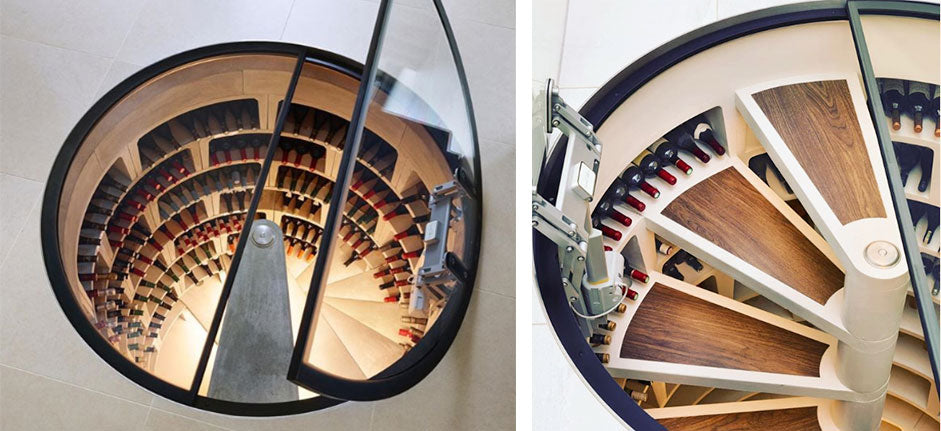
In 2018, a Sotheby’s auction made history when it saw a bottle of 1945 Romanée-Conti from the eponymous Domaine de la Romanée-Conti (DRC) fetch $558,000, a dizzying new record for the most expensive bottle of wine ever sold. At $91,600 a glass, the purchaser may not plan to pull the cork. However, should he want to, he can rest assured that the 74-year-old wine has been spent its entire life in the pristine cellars of Robert Drouhin. How you store a wine makes all the difference between a bottle of nectar and a bottle of very expensive vinegar and the Sotheby’s sale is a case in point of how deep into their pockets collectors are willing to dig for the guarantee of immaculate storage.
The ancient Greeks poured olive oil on top of wine to preserve it or stored it in amphorae buried in the ground. In the Middle Ages, only heavily fortified wine such as Madeira withstood the journey across the high seas. So rare was it for wine to reach England in a drinkable state that young, fresh wine fetched a much higher price than old wine. The invention of the cork in the 18th century was a glorious revelation: storing a wine in a bottle with a cork could actually improve it.
Today, confronted by the serried rows of homogenised, heavily branded bottles on the supermarket shelves, it can be easy to forget that wine is not just another inert product like instant coffee or a tin of beans to be used up by its best before date. Nothing could be further from the truth. From grape picking to the glass, wine undergoes a series of complex chemical reactions as it ages. The French call this process of maturation ‘élevage’, literally the upbringing or educating of the wine. The conditions in which these changes take place have a dramatic effect on what ends up in your glass (and on the resale value of your wines if your cellar is not purely for personal enjoyment).

Temperature is the first major consideration. Conventional wisdom puts the ideal cellar temperature at 11-13ºC. Prolonged exposure to anything significantly higher accelerates and changes the nature of the wine’s development. Anything significantly lower, while less damaging, will retard the wine’s march towards maturity. Extended periods of refrigeration can also cause corks to harden and lose elasticity which compromises the seal and sparkling wines lose their fizz.
Always store bottles on their side to ensure the wine remains in contact with the cork. A dried-out cork can let in air and oxidise the wine. Prolonged exposure to light, wildly fluctuating temperatures and extremes of humidity can also impact the quality of the cork and result in oxidation. Finally, avoid excessive vibrations so the wine can lie undisturbed.
Insights into good cellar conditions can be had from the winemakers themselves. In the Loire Valley troglodytic cellars carved deep into the chalky hillsides create cavernous tunnels where generations of wine mature gradually in the dark. Similar conditions are found throughout the wine-producing world, from the cool cathedral-like bodegas of Jerez in southern Spain to the hi-tech wizardry of New World wineries where temperature and humidity are regulated from awe-inspiring control panels. These conditions are replicated in professional wine storage facilities. Our sister company Private Reserves Ltd stores at Octavian where a series of limestone mines in Wiltshire, first converted by the Ministry of Defence during the Second World War, provide immaculate cellaring conditions.

There is something deeply pleasing about rows of bottles and neatly stacked wooden cases, and the ability to pick and choose on a daily basis from gently maturing treasures. If you have space, converting a room gives you the freedom to create your dream cellar. Any architect or designer worth their salt will be happy to advise you. Or simply find a reliable builder and source racks and shelving from wine rack and storage specialist Sorrells. Both Norcool and Fondis produce specialised cellar air-conditioning units and are able to advise on temperature and humidity control, just be wary of the electricity bills. The ingenious spiral cellar from the aptly named Spiral Cellars is a concrete cylindrical cellar sunk into the floor beneath a kitchen, dining room or garage holding up to 1,900 bottles of wine. As long as you don’t have anyone living underneath you, in fewer than 9 days you can have a clean, dark, naturally ventilated storage area with a constant temperature.

For those with a little less space, both Eurocave and La Sommelière have a vast range of temperature storage cabinets from sexy little slim-line numbers, holding just two cases which can be built-in to your kitchen, to their biggest model holding 229 bottles. This is state-of-the-art technology with locks and an alarm system that will tell you if you’ve been careless and left the door open.
Much like fine wine, spirits are now an established investment class and the question on how to store is a topical one. Spirits have a higher ABV so a bottle of whisky, for example, will not continue to develop in bottle like wine. However, proper storage is essential to retain aromas and prevent oxidation. Conveniently, spirits require the same storage conditions as wine with just one critical difference: spirits should always be stored vertically. Their higher alcohol content means they can react with the cork and cause it to decay and disintegrate, allowing oxygen to enter and spoil it. Turning the bottle upside down once a month will ensure that the cork stays sufficiently moist.

